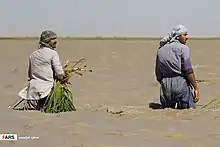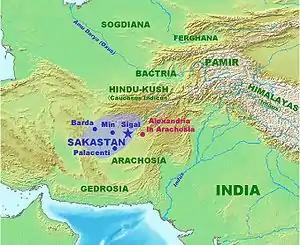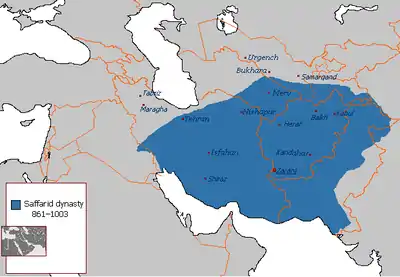Sistani Persians
Sistani Persians (Persian: مردم سیستانی) or Sistanis (historically sometimes referred to as Sagzi) are an ethnic Persian group,[1] who primarily inhabit Sistan in southeastern Iran and historically southwestern Afghanistan as well. They live in the northern part of Sistan and Balouchistan province, where they form a major minority (40–50% of the province) after the Baloch people. Their descendants in Afghanistan are primarily the Pashtun tribe of the Sakzai who are the largest ethnicity in the South-western parts of Afghanistan. Since recent decades many also have migrated to other parts of Iran such as Tehran and Golestan provinces in northern Iran.The largest city of Sistan region is Zabol. Sistanis speak a dialect of Persian known as Sistani or Zaboli.
 Sistani Persians near the Hamoun Lake | |
| Regions with significant populations | |
|---|---|
| Eastern Iran | |
| Languages | |
| Sistani Persian | |
| Religion | |
| Predominantly Shi'a Islam | |
| Related ethnic groups | |
| Other Iranian peoples |

Sistani Persians are Shia Muslims, in contrast to Baloch people who are Sunni Muslims. The Iranian Shia cleric Ayatollah Sistani, though from Mashhad, had an ancestor who moved to Sistan during the Safavid era to engage in religious activities in the region.
Etymology
Sistanis derive their name from Sakastan ("the land of the Saka"). The Sakas were a Scythian tribe migrated to the Iranian Plateau, The more ancient Old Persian name of the region – prior to Saka dominance – was Zaranka or Drangiana ("waterland"). This older form is also the root of the name Zaranj, capital of the Afghan Nimruz Province. The Drangians were listed among the peoples ruled by the legendary King Ninus before the Achaemenids. Its people were Zoroastrian. Sistan had a very strong connection with Zoroastrianism and during Sassanid times Lake Hamun was one of two pilgrimage sites for followers of that religion. In Zoroastrian tradition, the lake is the keeper of Zoroaster's seed and just before the final renovation of the world, three maidens will enter the lake, each then giving birth to the saoshyans who will be the saviours of mankind at the final renovation of the world.
In the Shahnameh, Sistan is also referred to as Zabulistan, after the region in the eastern part of present-day Afghanistan. In Ferdowsi's epic, Zabulistan is in turn described to be the homeland of the mythological hero Rostam.
History
Early History

The Drangians were listed among the peoples ruled by the legendary King Ninus before the Achaemenids.
Sassanian Era
The province was formed in ca. 240, during the reign of Shapur I, in his effort to centralise the empire; before that, the province was under the rule of the Parthian Suren Kingdom, whose ruler Ardashir Sakanshah became a Sasanian vassal Its people were Zoroastrian. Sistan had a very strong connection with Zoroastrianism and during Sassanid times Lake Hamun was one of two pilgrimage sites for followers of that religion. In Zoroastrian tradition, the lake is the keeper of Zoroaster's seed and just before the final renovation of the world, three maidens will enter the lake, each then giving birth to the saoshyans who will be the saviours of mankind at the final renovation of the world.
Islamic conquest
During the Muslim conquest of Persia, the last Sasanian king Yazdegerd III fled to Sakastan in the mid-640s, where its governor Aparviz (who was more or less independent), helped him. However, Yazdegerd III quickly ended this support when he demanded tax money that he had failed to pay.[2][3][4]
In 650, Abd-Allah ibn Amir, after having secured his position in Kerman, sent an army under Mujashi ibn Mas'ud to Sakastan. After having crossed the Dasht-i Lut desert, Mujashi ibn Mas'ud arrived to Sakastan. However, he suffered a heavy defeat and was forced to retreat.[5]
One year later, Abd-Allah ibn Amir sent an army under Rabi ibn Ziyad Harithi to Sakastan. After some time, he reached Zaliq, a border town between Kirman and Sakastan, where he forced the dehqan of the town to acknowledge Rashidun authority. He then did the same at the fortress of Karkuya, which had a famous fire temple, which is mentioned in the Tarikh-i Sistan.[4] He then continued to seize more land in the province. He thereafter besieged Zrang, and after a heavy battle outside the city, Aparviz and his men surrendered. When Aparviz went to Rabi to discuss about the conditions of a treaty, he saw that he was using the bodies of two dead soldiers as a chair. This horrified Aparviz, who in order to spare the inhabitants of Sakastan from the Arabs, made peace with them in return for heavy tribute, which included a tribute of 1,000 slave boys bearing 1,000 golden vessels.[4][3] Sakastan was thus under the control of the Rashidun Caliphate.
Post-Arab Islamic era

The Saffarid dynasty, which was the first fully independent Iranian empire after the Arab rule, was founded by Ya’qub Bin Laith Saffari. Ya'qub worked as a coppersmith (ṣaffār) before becoming a warlord. He seized control of the Sistan region and began conquering most of Iran, Afghanistan, Tajikistan, Turkmenistan and Uzbekistan up to the border of modern-day Iraq.
See also
References
- India, Survey of (1893). General Report. In these days the Sakas of Mushki , and the Sakazai , the chief section of the fast diminishing Sajadi clan , all claim to be Brahuis .
- Pourshariati 2008, p. 222.
- Morony 1986, pp. 203–210.
- Zarrinkub 1975, p. 24.
- Marshak & Negmatov 1996, p. 449.
Sources
- Marshak, B.I.; Negmatov, N.N. (1996). "Sogdiana". In B.A. Litvinsky, Zhang Guang-da and R. Shabani Samghabadi (ed.). History of Civilizations of Central Asia, Volume III: The Crossroads of Civilizations: A.D. 250 to 750. ISBN 92-3-103211-9.
- Morony, M. (1986). "ʿARAB ii. Arab conquest of Iran". Encyclopaedia Iranica, Vol. II, Fasc. 2. pp. 203–210.
- Pourshariati, Parvaneh (2008). Decline and Fall of the Sasanian Empire: The Sasanian-Parthian Confederacy and the Arab Conquest of Iran. London and New York: I.B. Tauris. ISBN 978-1-84511-645-3.
- Zarrinkub, Abd al-Husain (1975). "The Arab conquest of Iran and its aftermath". The Cambridge History of Iran, Volume 4: From the Arab Invasion to the Saljuqs. Cambridge: Cambridge University Press. pp. 1–57. ISBN 978-0-521-20093-6.